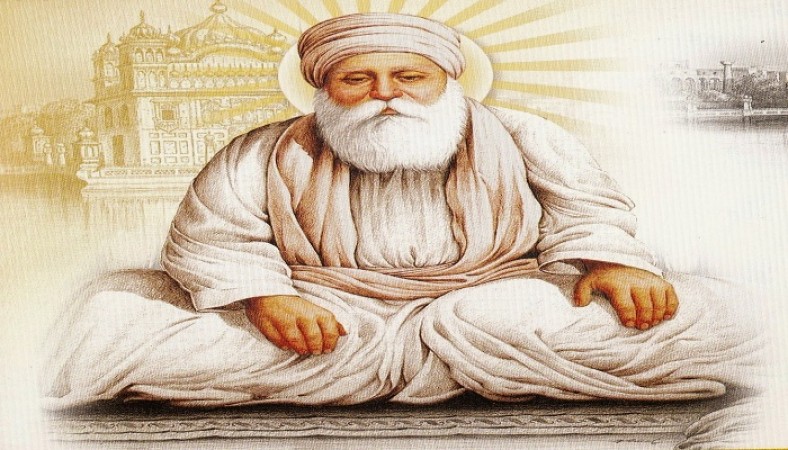
Guru Amardas ji was born on 5th May 1479 at Basarkay in Amritsar district. His father Tejbhan Bhalla was a middle-class farmer and trader. His mother Bhakht Kaur, also called Sulakhni, was a homely and pious lady. Born in a typical Vaishnava family, Amardas followed all traditional religious practices and abstained from meat. At the age of twenty-four, he married Mansa Devi. In due course, he had two sons - Mohri and Mohan, and two daughters - Dani and Bhani. He was religiously inclined and followed the Vaishnava mode of worship. From the age of forty-two, he started going to Hardwar for pilgrimage every year. After the death of his father (in 1553), he became the head of the family.
Once Sri Guru Amardas Ji heard some hyms of Sri Guru Nanak Dev Ji from Bibi Amro Ji, the daughter of Sri Guru Angad Dev Ji. He became too much impressed and immediately went to see Sri Guru Angad Dev Ji at Khadur Sahib. Under the impact of the teachings of Sri Guru Angad Dev Ji, Sri Guru Amardas Ji adopted him as his spiritual guide (Guru). Then he started living at Khadur Sahib. He used to rise early in the morning, bring water from the Bias River for Guru’s bath, and fetch wood from the Jungle for ‘Guru ka Langar’.
In March 1552, at the age of 73, Sri Guru Angad Dev Ji appointed Sri Guru Amardas Ji as the third Nanak. This came about as a result of his commitment to Sri Guru Angad Dev Ji and his teachings, as well as his services. He set up shop in the brand-new town of Goindwal. There, he carefully plotted out how to spread the Sikh faith. He separated the Sikh Sangat region into 22 preaching centers (Manjis), each overseen by a devoted Sikh. He traveled to India and dispatched Sikh missionaries to various regions to propagate Sikhism.
Also ReadGuru Hargobind Singh Ji: Quality of Swords
He enhanced the custom known as "Guru ka Langer" and made it mandatory for everyone visiting the Guru to say, "Pehle Pangat Phir Sangat." The emperor Akbar once visited Guru Sahib, but before he could speak with him, he had to consume some of the coarse rice from the Langar. He was so fascinated by this arrangement that he requested some royal property for "Guru ka Langar," but Guru Sahib respectfully rejected it. While crossing the Yamuna and Ganga, Sri Guru Amardas Ji urged Akbar to waive the toll tax (pilgrim's tax) for non-Muslims. Akbar complied. Emperor Akbar and Sri Guru Amardas Ji remained friendly.
He promoted widow remarriage and campaigned against Sati. He commanded the women to take off their "Purdah" (veil). He created new rituals for birth, marriage, and death. As a result, he erected a fence around a young religion like that of Sikhism and was faced with fierce opposition from hardline Muslims and Orthodox Hindus. For the three Sikh holidays—Dewali, Vaisakhi, and Maghi—he scheduled three Gurpurbs. It was forbidden to visit Hindu pilgrimage sites or pay respect to Muslim sites.
Also ReadGuru Ram Das Ji: Developed Amritsar
Sri Guru Amardas Ji constructed Baoli at Goindwal Sahib having eighty-four steps and made it a Sikh pilgrimage center for the first time in the history of Sikhism. He reproduced more copies of the hymns of Sri Guru Nanak Dev Ji and Sri Guru Angad Dev Ji. He also composed 869 (according to some chronicles these were 709) verses (stanzas) including Anand Sahib, and Sri Guru Arjan Dev Ji made all the Shabads part of Guru Granth Sahib.
None of Sri Guru Amardas Ji's sons were deemed suitable for the position of guru, therefore he instead chose his son-in-law (Guru) Ramdas Ji to succeed him. The fact that Bibi Bhani ji and Guru Ramdas Sahib had a genuine spirit of service and a thorough comprehension of Sikh ideals made it a practical rather than an emotional decision. This practice demonstrates that the Guruship may be transferred to any person who was suitable for the Sikh cause, regardless of whether they belonged to the same family or not. At the age of 95, Sri Guru Amardas Ji went away to heaven at Goindwal Sahib near the district of Amritsar on Bhadon Sudi 14th, (1st Assu) Samvat 1631, (September 1, 1574) after entrusting Guruship to the Fourth Nanak, Sri Guru Ramdas Ji.